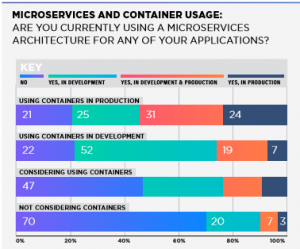There is a lot of buzz in the market on the topics of Microservices, Containers, and DevOps. Let’s see how organizations and their IT teams can produce new software capabilities and services more efficiently by utilizing a modern application software design and development processes such as Container-based Microservices and DevOps methodology
Microservices and containers
Containers and microservices are rapidly becoming the norm for enterprise organizations. According to the DZone Guide to Microservices, 64 percent of technology professionals used containers in the mainstream in 2017 and 89 percent are either already using or interested in using microservices.


Source: DZone
Containers are often used to run each individual Microservice, serving as convenient, lightweight “envelopes” that allow the software to be truly portable. They offer the right abstraction to encapsulate Microservices and both enable agility, speed and resource efficiency for many tasks that developers work daily.
Microservices and DevOps
Another trend that is capturing the imagination of enterprise IT is Microservices with DevOps, which is changing the way they work today. According to industry analysis, the DevOps & Microservice Ecosystem market will grow globally at a robust CAGR of 16% between 2017 and 2022, reaching $10 billion by 2021.
The evolution of DevOps and Microservices started with transforming monolithic applications into decomposed services. As organizations realize that agile transformation in application development isn’t enough to meet the agility needs of today’s fast-paced, hyper-competitive markets, they are fast embracing DevOps as the de facto IT mantra. In general, DevOps represents more of a cultural shift for developers than a technological one. With traditional, monolithic applications, there is a steep learning curve for developers to become familiar with a particular codebase. In a DevOps environment, there’s more flexibility. Once the organization understands the value of DevOps, they transform themselves culturally to bring in close collaboration between different stakeholders (developers, operations and businesses) and pick the right tools to complement each other.
Microservices architecture emerged from a common set of DevOps ideologies that came into being at companies like Amazon, Netflix, Facebook, Google, and several others. Those companies that excelled at DevOps also shared common approaches to software development and had similar organizational structures and development cultures. Looking for a vendor who has knowledge and experience in the technologies and industries that you need is important.
Microservices + containers = successful DevOps
While the benefits of DevOps are obvious, the intersection between using microservices and containers to support a DevOps environment is starting to become clear. DevOps approach targets the entire software delivery pipeline which can increase deployment frequency and lead to faster time-to-market for products. Organizations that use DevOps often see lower failure rates of new releases, shortened lead time between fixes and faster mean time to recovery.
Another benefit of using containers and microservices in a DevOps environment is that developers can independently deploy each service, which helps with fault isolation. If a part is problematic in a monolithic application, those issues can bring down the entire system. With containerization and microservices, that’s not the case.
Consider two key aspects of microservices
- Packaging and deploying applications so they are portable across cloud providers.
- Model the application into loosely coupled, single-function components that use REST for communication.
Organizations use containers to package and deploy monolithic and microservices-based applications. Many developers use Dockers, such as, because it offers a simple way to package the code and push it to the release pipeline, which streamlines the DevOps workflow.
With DevOps and microservices, developer teams can work on the loosely coupled application and choose the technology stack best suited for their requirements. It also enables new team members to ramp up more quickly to become familiar with the service they are working on.
Conclusion
The combination of Microservices, Containers, and DevOps has a great potential to transform enterprise IT and help organizations compete effectively not just today but also in the future.
There is no doubt that the combination of Microservices, Containers, and DevOps together work better together. With increased agility and flexibility, microservices and containers can be an ideal complement to an enterprise’s DevOps environment.
Read more about this topic here.


